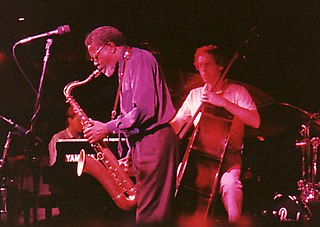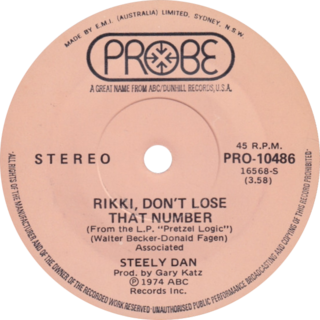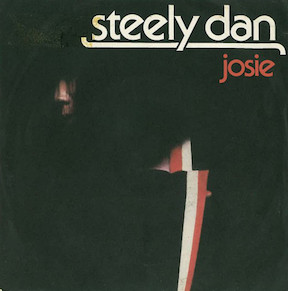Related Research Articles

Steely Dan is an American rock band founded in 1971 in New York by Walter Becker and Donald Fagen. Initially the band had a stable lineup, but in 1974 Becker and Fagen retired from live performances to become a studio-only band, opting to record with a revolving cast of session musicians. Rolling Stone has called them "the perfect musical antiheroes for the seventies".

Hard bop is a subgenre of jazz that is an extension of bebop music. Journalists and record companies began using the term in the mid-1950s to describe a new current within jazz that incorporated influences from rhythm and blues, gospel music, and blues, especially in saxophone and piano playing.

Horace Ward Martin Tavares Silver was an American jazz pianist, composer, and arranger, particularly in the hard bop style that he helped pioneer in the 1950s.

Soul jazz or funky jazz is a subgenre of jazz that incorporates strong influences from hard bop, blues, soul, gospel and rhythm and blues. Soul jazz is often characterized by organ trios featuring the Hammond organ and small combos including saxophone, brass instruments, electric guitar, bass, drums, piano, vocals and electric organ. Its origins were in the 1950s and early 1960s, with its heyday with popular audiences preceding the rise of jazz fusion in the late 1960s and 1970s. Prominent names in fusion ranged from bop pianists including Bobby Timmons and Junior Mance to a wide range of organists, saxophonists, pianists, drummers and electric guitarists including Jack McDuff, Eddie "Lockjaw" Davis, and Grant Green.
Latin jazz is a genre of jazz with Latin American rhythms. The two main categories are Afro-Cuban jazz, rhythmically based on Cuban popular dance music, with a rhythm section employing ostinato patterns or a clave, and Afro-Brazilian jazz, which includes samba and bossa nova.

Joe Henderson was an American jazz tenor saxophonist. In a career spanning more than four decades, Henderson played with many of the leading American players of his day and recorded for several prominent labels, including Blue Note, Milestone, and Verve.

Pretzel Logic is the third studio album by American rock band Steely Dan, released by ABC Records on February 20, 1974. It was recorded at the Village Recorder in West Los Angeles, California, with producer Gary Katz. The album was Steely Dan's last to be made and released while the group was still an active touring band, as well as the final album to feature the band's full quintet-lineup of Becker, Fagen, Denny Dias, Jim Hodder, and Jeff "Skunk" Baxter, though it also features significant contributions from many prominent Los Angeles-based studio musicians.

"Night and Day" is a popular song by Cole Porter that was written for the 1932 musical Gay Divorce. It is perhaps Porter's most popular contribution to the Great American Songbook and has been recorded by dozens of musicians. NPR says "within three months of the show's opening, more than 30 artists had recorded the song."

Song for My Father is a 1965 album by the Horace Silver Quintet, released on the Blue Note label in 1965. The album was inspired by a trip that Silver had made to Brazil. The cover artwork features a photograph of Silver's father, John Tavares Silver, to whom the title composition was dedicated. "My mother was of Irish and Negro descent, my father of Portuguese origin," Silver recalls in the liner notes: "He was born on the island of Maio, one of the Cape Verde Islands."

The Cape Verdean Blues is a 1966 album by a jazz quintet led by pianist Horace Silver. The quintet is augmented on the last three tracks on the album by trombonist J. J. Johnson. The album was inspired by Silver's father, John Tavares Silva, who was born in Cape Verde.

Jazz improvisation is the spontaneous invention of melodic solo lines or accompaniment parts in a performance of jazz music. It is one of the defining elements of jazz. Improvisation is composing on the spot, when a singer or instrumentalist invents melodies and lines over a chord progression played by rhythm section instruments and accompanied by drums. Although blues, rock, and other genres use improvisation, it is done over relatively simple chord progressions which often remain in one key.

"Rikki Don't Lose That Number" is a single released in 1974 by rock/jazz rock group Steely Dan and the opening track of their third album Pretzel Logic. It was the most successful single of the group's career, peaking at number 4 on the Billboard Hot 100 in the summer of 1974.
Roger Humphries is an American jazz drummer.
Theodore Smith was an American jazz double-bassist.
In the late 1960s, Latin jazz, combining rhythms from African and Latin American countries, often played on instruments such as conga, timbale, güiro, and claves, with jazz and classical harmonies played on typical jazz instruments broke through. There are two main varieties: Afro-Cuban jazz was played in the US right after the bebop period, while Brazilian jazz became more popular in the 1960s. Afro-Cuban jazz began as a movement in the mid-1950s as bebop musicians such as Dizzy Gillespie and Billy Taylor started Afro-Cuban bands influenced by such Cuban and Puerto Rican musicians as Xavier Cugat, Tito Puente, and Arturo Sandoval. Brazilian jazz such as bossa nova is derived from samba, with influences from jazz and other 20th-century classical and popular music styles. Bossa is generally moderately paced, with melodies sung in Portuguese or English. The style was pioneered by Brazilians João Gilberto and Antônio Carlos Jobim. The related term jazz-samba describes an adaptation of bossa nova compositions to the jazz idiom by American performers such as Stan Getz and Charlie Byrd.

"Josie" is a song written by Walter Becker and Donald Fagen and first released by Steely Dan on their 1977 album Aja. It was also released as the third single from the album and performed modestly well, reaching #26 on the Billboard Hot 100 and #44 on the Easy Listening chart that year. It has appeared on several Steely Dan live and compilation albums.
"Aja" is a jazz rock song, with elements of jazz fusion and progressive rock, by the American rock band Steely Dan from the album of the same name, their sixth studio album, released in 1977. Composers Becker and Fagen play guitar and synthesizer, respectively, on the song, with various studio musicians playing the other parts; Fagen sings lead vocals. Production duties were handled by Gary Katz; the album was released through ABC Records. Musically, it is a tonally sophisticated and structurally complex work that was praised on its release as the most ambitious track the duo had ever attempted. The song's lyrics center around the interior monologue of a man who runs to the title character to escape the stresses of his life "up on the hill." Fagen claimed that it was inspired by a relative of someone he knew, who had married a Korean woman named Aja. He has described the song as being about the "tranquility that can come of a quiet relationship with a beautiful woman."
"The Preacher" is a composition by Horace Silver. The original version was recorded by Silver's quintet on February 6, 1955. It was soon covered by other musicians, including with lyrics added by Babs Gonzales. It has become a jazz standard.
"Señor Blues" is a composition by Horace Silver. The original version, an instrumental by Silver's quintet, was recorded on November 10, 1956. It has become a jazz standard. Silver later wrote lyrics, which were first recorded by Silver's band with Bill Henderson singing in 1958.
"Recorda Me", which translates to "Remember Me" from Portuguese, is a jazz standard by the saxophonist Joe Henderson. It was introduced on Henderson's debut album Page One, in 1963. This album also featured the first recording of the jazz standard "Blue Bossa", written by trumpeter Kenny Dorham. English lyrics were later written by vocalist Kelley Johnson under the title "Remember Me.'
References
- ↑ Keepnews, Peter (June 18, 2014). "Horace Silver, 85, Master of Earthy Jazz, Is Dead". The New York Times .
- ↑ "Jazz omkring midnat: Horace Silver Quintet live at the Copenhagen Jazzfestival 1968". DR - Danish Broadcasting Corporation. Retrieved November 29, 2020.
- 1 2 3 4 5 Meadows, Eddie S. (2013) Jazz: Research and Pedagogy (3rd ed.). Routledge.
- 1 2 Owens, Thomas (1996). Bebop – The Music and Its Players. Oxford University Press. p. 222. ISBN 978-0-19-510651-0.
- 1 2 Silver, Horace (2006). Let's Get to the Nitty Gritty : The Autobiography of Horace Silver. University of California Press. pp. 111–112. ISBN 9780520253926.
- 1 2 3 4 Kirchner, Bill "The Dozens: Horace Silver" Archived September 24, 2008, at the Wayback Machine , jazz.com. Retrieved January 1, 2016.
- ↑ McDonough, John (September 2014), "Horace Silver". Down Beat , p. 49.
- ↑ Mason, Stewart. "Steely Dan 'Rikki Don't Lose That Number'". AllMusic. Retrieved November 5, 2014.
- ↑ Huey, Steve. "Song for My Father (1964)". Blue Note Records. Retrieved November 5, 2014.